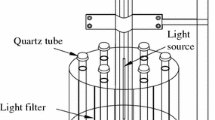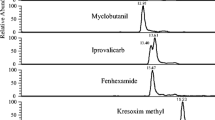Abstract
The photochemically mediated dechlorination of polyhalogenated compounds represents a potential decontamination strategy and a relevant environmental process in chemically reducing media. We report the UV irradiation of natural and artificial waters containing natural dissolved organic matter to effect the photo-sensitized degradation of chlorinated organic compounds, including tetrachloromethane, 1,1,1-tricloroethane, perchloroethene, 1,2-dibromo-3-chloropropane and chlorobenzene at trace (ppb) levels in aqueous solution. The degradation kinetics are followed in situ using membrane introduction mass spectrometry. By re-circulating the reaction mixture in a closed loop configuration over a semi-permeable hollow fiber polydimethylsiloxane membrane in a flow cell interface, volatile and semi-volatile compounds are continuously monitored using a quadrupole ion trap mass spectrometer. The time resolved quantitative information provides useful mechanistic insights, including kinetic data. Pseudo first-order rate constants for the degradation of contaminant mixtures in natural waters are reported.
Similar content being viewed by others
References
D. C. G. Muir, P. H. Howard, Are there other persistent organic pollutants? A challenge for environmental chemists, Environ. Sci. Technol., 2006, 40, 7157–7166.
R. P. Schwarzenbach, P. M. Gschwend and D. M. Imboden, Environmental Organic Chemistry, Wiley, 2003.
J. H. He, W. P. Ela, E. A. Betterton, R. G. Arnold, A. E. Saez, Reductive dehalogenation of aqueous-phase chlorinated hydrocarbons in an electrochemical reactor, Ind. Eng. Chem. Res., 2004, 43, 7965–7974.
P. K. Freeman, C. M. Haugen, Differential photohydrodehalogenation reactivity of bromobenzenes (1,2,4-tribromobenzene, 1,2,3,5-tetrabromobenzene) and pentachlorobenzene: Sunlight-based remediation, J. Chem. Technol. Biotechnol., 1998, 72, 45–49.
G. P. Curtis, M. Reinhard, Reductive dehalogenation of hexachloroethane, carbon tetrachloride, and bromoform by anthrahydroquinone disulfonate and humic acid, Environ. Sci. Technol., 1994, 28, 2393–2401.
J. Gan, Q. Wang, S. R. Yates, W. C. Koskinen, W. A. Jury, Dechlorination of chloroacetanilide herbicides by thiosulfate salts, Proc. Natl. Acad. Sci. U. S. A., 2002, 99, 5189–5194.
W. Zhang, L. Li, B. Z. Li, K. F. Lin, S. G. Lu, R. B. Fu, J. Zhu, X. H. Cui, Mechanism and pathway of tetrachloroethylene dechlorination by zero-valent iron with Cu or Cu/C, J. Environ. Eng., 2013, 139, 803–809.
X. Lu and S. Yuan, Electrokinetic removal of chlorinated organic compounds, in Electrochemical Remediation Technologies for Polluted Soils, Sediments and Groundwater, John Wiley & Sons, Inc., 2009, pp. 219–234.
J. A. Perlinger, J. Buschmann, W. Angst, R. P. Schwarzenbach, Iron porphyrin and mercaptojuglone mediated reduction of polyhalogenated methanes and ethanes in homogeneous aqueous solution, Environ. Sci. Technol., 1998, 32, 2431–2437.
J. P. Aguer, C. Richard, F. Andreux, Effect of light on humic substances: Production of reactive species, Analusis, 1999, 27, 387–390.
M. Lal, C. Schoneich, J. Monig, K. D. Asmus, Rate constants for the reactions of halogenated organic radicals, Int. J. Radiat. Biol., 1988, 54, 773–785.
A. Matsunaga, A. Yasuhara, Dechlorination of PCBs by electrochemical reduction with aromatic radical anion as mediator, Chemosphere, 2005, 58, 897–904.
E. A. Betterton, N. Hollan, R. G. Arnold, S. Gogosha, K. McKim, Z. J. Liu, Acetone-photosensitized reduction of carbon tetrachloride by 2-propanol in aqueous solution, Environ. Sci. Technol., 2000, 34, 1229–1233.
H. Li, E. A. Betterton, R. G. Arnold, W. P. Ela, B. Barbaris, C. Grachane, Convenient new chemical actinometer based on aqueous acetone, 2-propanol, and carbon tetrachloride, Environ. Sci. Technol., 2005, 39, 2262–2266.
N. J. Turro, V. Ramamurthy and J. C. Scaiano, Principles of Molecular Photochemistry: An Introduction, University Science Books, 2009.
Y. P. Chin, P. L. Miller, L. Zeng, K. Cawley, L. Weavers, Photosensitized degradation of bisphenol A by dissolved organic matter, Environ. Sci. Technol., 2004, 38, 5888–5894.
E. C. Minor, M. M. Swenson, B. M. Mattson, A. R. Oyler, Structural characterization of dissolved organic matter: A review of current techniques for isolation and analysis, Environ. Sci.: Processes Impacts, 2014, 16, 2064–2079.
J. L. Weishaar, G. R. Aiken, B. A. Bergamaschi, M. S. Fram, R. Fujii, K. Mopper, Evaluation of specific ultraviolet absorbance as an indicator of the chemical composition and reactivity of dissolved organic carbon, Environ. Sci. Technol., 2003, 37, 4702–4708.
T. E. Thomas-Smith, N. V. Blough, Photoproduction of hydrated electron from constituents of natural waters, Environ. Sci. Technol., 2001, 35, 2721–2726.
R. G. Zepp, P. F. Schlotzhauer, R. M. Sink, Photosensitized transformations involving electronic-energy transfer in natural waters: Role of humic substances, Environ. Sci. Technol., 1985, 19, 74–81.
S. H. Kang, W. Choi, Oxidative degradation of organic compounds using zero-valent iron in the presence of natural organic matter serving as an electron shuttle, Environ. Sci. Technol., 2008, 43, 878–883.
F. M. Dunnivant, R. P. Schwarzenbach, D. L. Macalady, Reduction of substituted nitrobenzenes in aqueous solutions containing natural organic matter, Environ. Sci. Technol., 1992, 26, 2133–2141.
R. G. Zepp, A. M. Braun, J. Hoigne, J. A. Leenheer, Photoproduction of hydrated electrons from natural organic solutes in aquatic environments, Environ. Sci. Technol., 1987, 21, 485–490.
R. A. Ketola, T. Kotiaho, M. E. Cisper, T. M. Allen, Environmental applications of membrane introduction mass spectrometry, J. Mass Spectrom., 2002, 37, 457–476.
R. C. Johnson, R. G. Cooks, T. M. Allen, M. E. Cisper, P. H. Hemberger, Membrane introduction mass spectrometry: Trends and applications, Mass Spectrom. Rev., 2000, 19, 1–37.
N. G. Davey, E. T. Krogh, C. G. Gill, Membrane introduction mass spectrometry (MIMS), Trends Anal. Chem., 2011, 30, 1477–1485.
M. A. LaPack, J. C. Tou, C. G. Enke, Membrane mass spectrometry for the direct trace analysis of volatile organic compounds in air and water, Anal. Chem., 1990, 62, 1265–1271.
E. T. Krogh, C. G. Gill, Membrane introduction mass spectrometry (MIMS): A versatile tool for direct, real-time chemical measurements, J. Mass Spectrom., 2014, 49, 1205–1213.
J. T. Borges, R. Sparrapan, J. R. Guimaraes, M. N. Eberlin, R. Augusti, Chloroform formation by chlorination of aqueous algae suspensions: Online monitoring via membrane introduction mass spectrometry, J. Braz. Chem. Soc., 2008, 19, 950–955.
F. R. Lauritsen, S. Gylling, Online monitoring of biological reactions at low parts-per-trillion levels by membrane inlet mass spectrometry, Anal. Chem., 1995, 67, 1418–1420.
R. M. Alberici, M. A. Mendes, W. F. Jardim, M. N. Eberlin, Mass spectrometry on-line monitoring and MS2 product characterization of TiO2/UV photocatalytic degradation of chlorinated volatile organic compounds, J. Am. Soc. Mass Spectrom., 1998, 9, 1321–1327.
K. Beckmann, J. Messinger, M. R. Badger, T. Wydrzynski, W. Hillier, On-line mass spectrometry: Membrane inlet sampling, Photosynth. Res., 2009, 102, 511–522.
P. S. H. Wong, N. Srinivasan, N. Kasthurikrishnan, R. G. Cooks, J. A. Pincock, J. S. Grossert, On-line monitoring of the photolysis of benzyl acetate and 3,5-dimethoxybenzyl acetate by membrane introduction mass spectrometry, J. Org. Chem., 1996, 61, 6627–6632.
J. H. L. Nelson, D. A. Friesen, C. G. Gill, E. T. Krogh, On-line measurement of oxidative degradation kinetics for trace gasoline contaminants in aqueous solutions and natural water by membrane introduction tandem mass spectrometry, J. Environ. Sci. Health, Part A, 2010, 45, 1720–1731.
R. Augusti, A. Dias, L. Rocha, R. Lago, Kinetics and mechanism of benzene derivative degradation with Fenton’s reagent in aqueous medium studied by MIMS, J. Phys. Chem. A, 1998, 102, 10723–10727.
R. Rios, L. L. da Rocha, T. G. Vieira, R. M. Lago, R. Augusti, On-line monitoring by membrane introduction mass spectrometry of chlorination of organics in water: Mechanistic and kinetic aspects of chloroform formation, J. Mass Spectrom., 2000, 35, 618–624.
F. Soltermann, S. Canonica, U. von Gunten, Trichloramine reactions with nitrogenous and carbonaceous compounds: Kinetics, products and chloroform formation, Water Res., 2015, 71, 318–329.
M. Izadifard, 2012, personal communication.
D. W. Janes, C. J. Durning, D. M. van Pel, M. S. Lynch, C. G. Gill, E. T. Krogh, Modeling analyte permeation in cylindrical hollow fiber membrane introduction mass spectrometry, J. Membr. Sci., 2008, 325, 81–91.
P. L. Miller, Y. P. Chin, Photoinduced degradation of carbaryl in a wetland surface water, J. Agric. Food Chem., 2002, 50, 6758–6765.
R. M. Cory, J. B. Cotner, K. McNeill, Quantifying interactions between singlet oxygen and aquatic fulvic acids, Environ. Sci. Technol., 2009, 43, 718–723.
U.S. Environmental Protection Agency, Basic Information about Regulated Drinking Water Contaminants and Indicators, 2015.
World Health Organization, Guidelines for Drinking-water Quality, Geneva, 4th edn, 2011.
U.S. Public Health Service: Agency for Toxic Substances and Disease Registry, Toxicological Profile for Chlorobenzene, Atlanta, GA, 1990.
J. H. Montgomery, Groundwater Chemicals Desk Reference, CRC Press, Boca Raton, 2007.
J. M. Michael, Occurrence and Implications of Selected Chlorinated Solvents in Ground Water and Source Water in the United States and in Drinking Water in 12 Northeast and Mid-Atlantic States, 1993–2002, U.S. Geological Survey, Reston, Virginia, 2005.
Author information
Authors and Affiliations
Corresponding author
Rights and permissions
About this article
Cite this article
Letourneau, D.R., Gill, C.G. & Krogh, E.T. Photosensitized degradation kinetics of trace halogenated contaminants in natural waters using membrane introduction mass spectrometry as an in situ reaction monitor. Photochem Photobiol Sci 14, 2108–2118 (2015). https://doi.org/10.1039/c5pp00286a
Received:
Accepted:
Published:
Issue Date:
DOI: https://doi.org/10.1039/c5pp00286a




